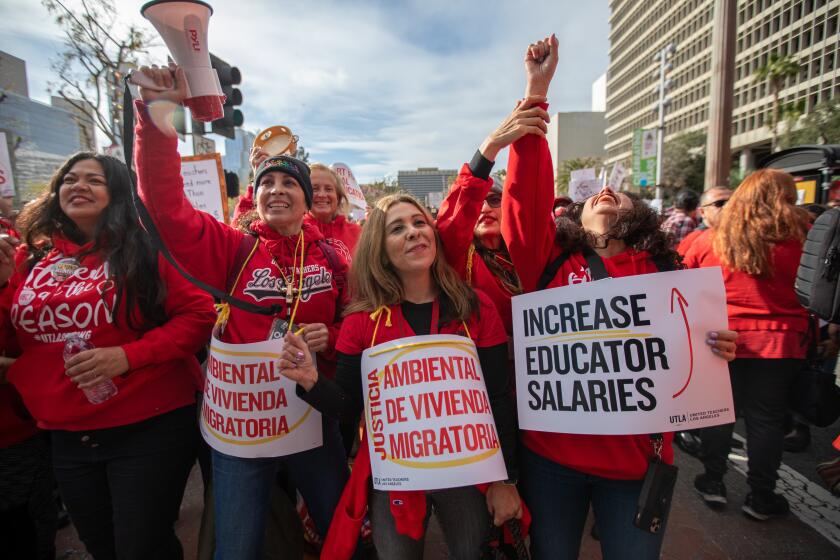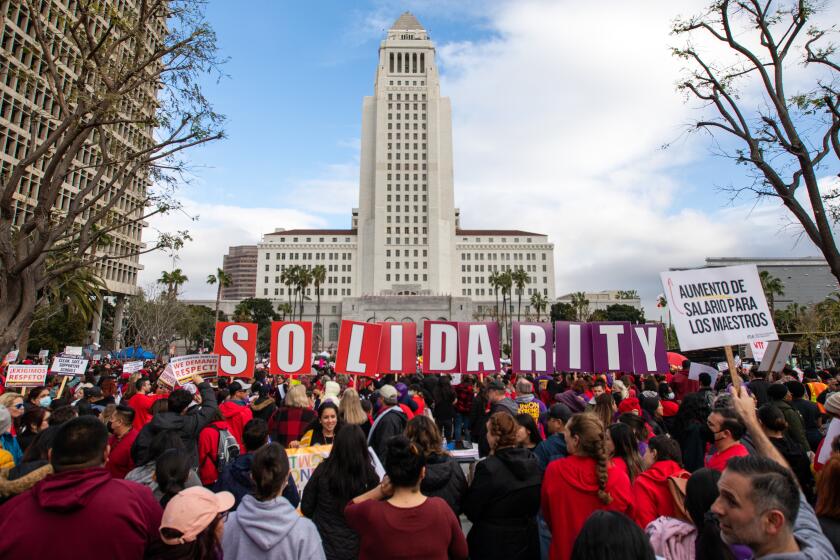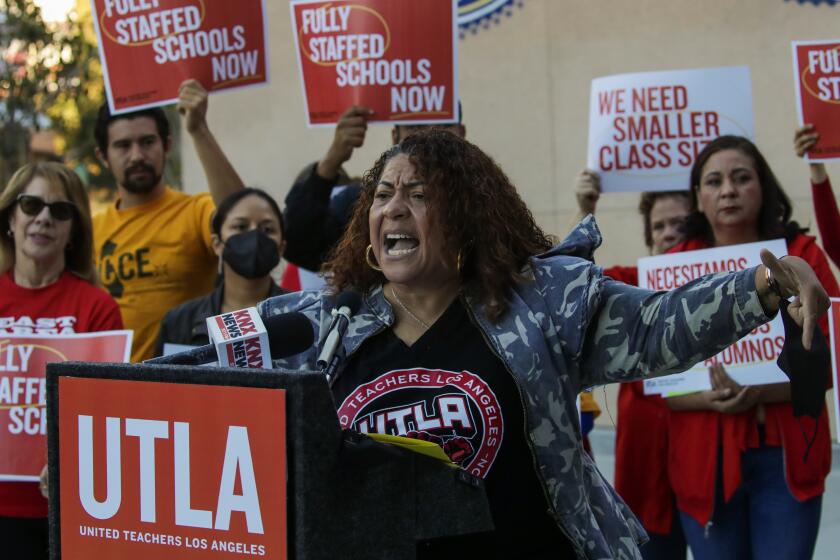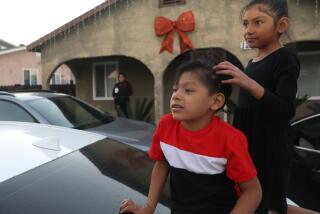How LAUSD is scrambling to prepare for a three-day strike affecting 420,000 children
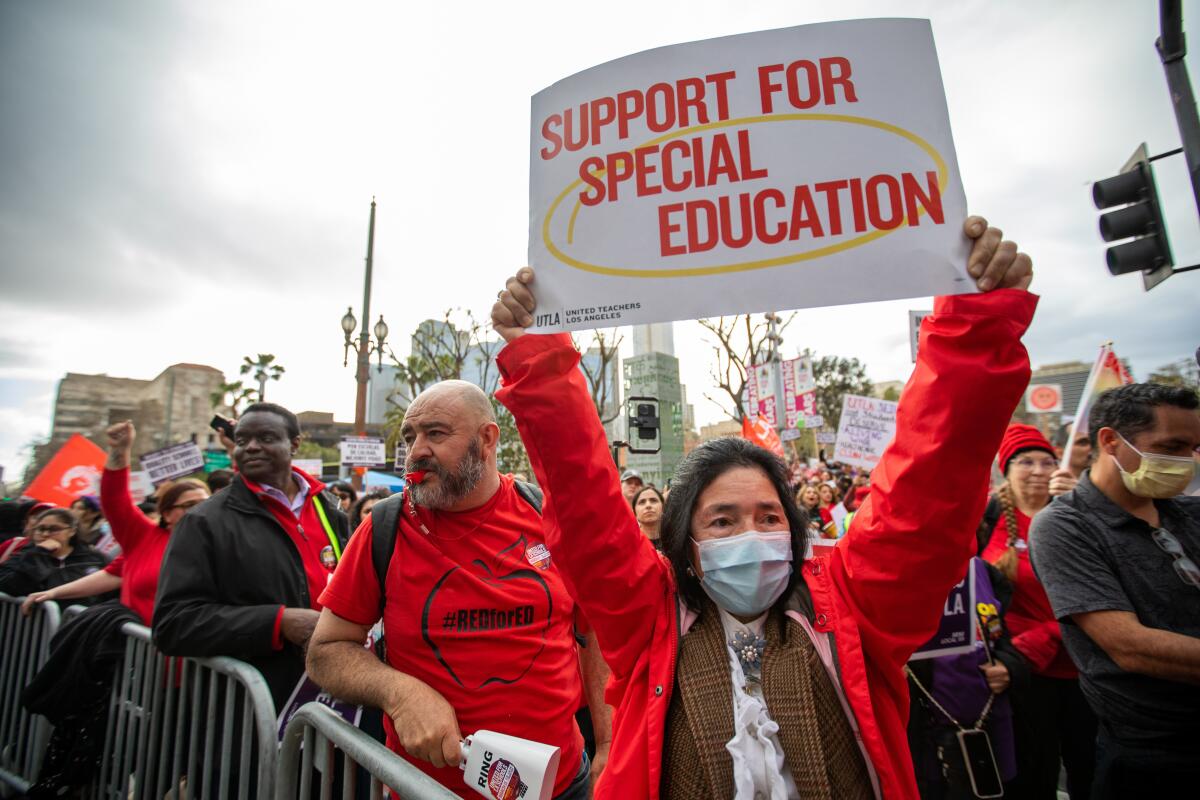
- Share via
A day after unions representing both teachers and support staff announced a three-day strike starting Tuesday, the Los Angeles Unified School District was scrambling to prepare for the looming shutdown of 1,000 campuses — while at the same time, trying to prevent the massive walkout.
School work won’t be graded. Breakfast, lunch and sometimes dinner for children from low-income families might be provided — from some place yet to be determined. Child care? That will be a challenge. Nonprofit groups throughout the city are hastily moving to help, but they won’t fill the gap.
“We’re trying to see if we can minimize the consequences of a three-day strike on people for whom schools provide food and child care in addition to education,” school board President Jackie Goldberg said. “We are not sure we will be able to do so. But we are not going to stop making efforts because we have four or five days to work on it.”
There is a lot to do — and a lot that won’t be doable.
Unable to ensure the supervision and safety of children with up to 65,000 workers on strike, the district said it must close schools to students. The first-time walkout of the district’s two largest unions includes teachers, librarians, counselors, nurses, bus drivers, cafeteria workers, gardeners, custodians and teacher aides.
Campuses will be open, however, to employees who want to work. They will be paid; strikers will not. Keeping campuses open also will provide support for students and parents who stop by with issues.
The planned three-day walkout by support staff and teachers in L.A. Unified would shut down schools. Supt. Alberto Carvalho said he is prepared to bargain around the clock.
“We’re not going to lock anybody out,” Goldberg said. “Everybody will make their own decision.”
If enough employees choose to work on Tuesday, the school system could reevaluate whether it could provide supervision and food on campus for Wednesday, she added.
Goldberg said she remained optimistic that a strike could be averted by making progress in bargaining with the two striking unions: United Teachers Los Angeles and Local 99 of Service Employees International.
“UTLA will be bargaining with us starting [Friday] morning,” Goldberg said Thursday. “And if that goes well, they may be able to encourage their partner in all of this to come back to the table. So I’m still optimistic, cautiously, but optimistic.”
The teachers union is seeking a 20% raise over two years, but has a detailed, far-reaching platform that includes guaranteed support for a special initiative for Black students and housing for low-income families.
Local 99 officials deny that they have stopped bargaining, but as of early Thursday night had not scheduled talks before the Tuesday strike.
The union said it is waiting for state labor officials to set up a fact-finding panel as part of the negotiation process. If L.A. Unified wants to jump-start talks before that, the district would have to agree to the union’s demand for a 30% raise plus a $2-per-hour additional raise for the lowest-paid workers, said Executive Director Max Arias.
District officials are making contingency plans to provide schoolwork, food and supervision.
Across the school system, principals held online meetings Thursday using a slide deck provided by the central office.
LAUSD teachers and staff unions plan three-day strike beginning Tuesday, shutting schools down. What you need to know.
Parents learned that students would be issued a computer to use at home — if they don’t already have one. Teachers are to send home pencil-and-paper packets for children in second grade and younger. School websites will be populated with links to general grade-appropriate schoolwork developed by the school district.
Goldberg said it is crucial for teachers to prepare appropriate work for students — and they still have time to do so before the work stoppage.
“Things can change at any moment,” one elementary school administrator told parents, adding that the school’s website would be updated day and night.
At one school presentation, worried parents wanted to know: Will the strike last longer than three days? Will the missed days be made up?
The strike is scheduled for a fixed duration, but there’s no guarantee of a settlement by the time it ends.
There are no plans to make up missed days, although the district is encouraging parents to sign up for optional, extra learning time already scheduled for April 3 and 4, the first two days of spring break.
Administrators also stated that academic work provided during the strike would not factor into a student’s grade, a number of parents said.
“The slides included all the wealth of academic links with work that the kids ‘could’ do as they don’t want them sitting around not working,” said parent Frankie Bean, from the Reseda area, in a parents Facebook group. “Bottom line, it is NO substitute for the work assigned by their beloved teachers. It’s busy work and I am so grateful to our [vice-principal] for telling us parents that it was not mandatory.”
Bean added: “More district propaganda to make the teachers look like bad guys. ‘Hey kids, your teachers don’t care about you or your education, but look at these goodies we put together for YOU, because WE care about you.’”
The district has reached out for help to L.A. Mayor Karen Bass and other city officials.
The hope is that the city can quickly ramp up programs that typically operate during the summer — when most students are out of school. During the summer, these programs provide food, activities and supervision.
The union that staged a strike and pushed hard for COVID safety — inspiring love and loathing among parents — is electing its leaders.
“The mayor is closely monitoring the situation and is engaged with all parties involved,” said Bass spokesperson Zach Seidl.
Rose Watson, a spokesperson for the city’s Department of Recreation and Parks, said her agency is looking at opening as many as 22 recreation centers across the city for daylong activities.
Those locations would operate from 7:30 a.m. to 6 p.m.
“It will be like what we did during COVID, where we provided services where we could assist them with homework assignments,” Watson said.
Goldberg said the district would try to provide these centers with food, although food-service workers are represented by Local 99.
The school system extends well beyond Los Angeles city boundaries, so potential collaboration extends to other cities and county agencies.
The county’s Department of Parks and Recreation plans to provide all-day recreation activities at 16 of its parks, said Liz Odendahl, spokeswoman for Supervisor Janice Hahn.
Goldberg said the child-care problem would be the most challenging.
At the southern end of the district, leaders of the Boys & Girls Clubs of the Los Angeles Harbor have decided to provide programming — arts, music, sports and academic activities — all day long at its six nonschool sites in San Pedro, Wilmington and other nearby neighborhoods.
On the three strike days, doors would open at 8 a.m. instead of 2:30 p.m., said Mike Lansing, a former L.A. school board member and the group’s chief executive. Breakfast, lunch and a snack would be offered during the day.
“We’re trying to get ahead of this, so we can help the families that normally count on us,” he said.
But he conceded there would be limitations.
“We can’t take everybody,” Lansing said. “We just don’t have the capacity. But anyone that’s a member will be able to come for free,” he said. Yearly memberships are $25.
On L.A.’s Eastside, the nonprofit InnerCity Struggle plans to open its community center on Whittier Boulevard in Boyle Heights, providing educational activities, homework support and meals — breakfast, lunch and snacks — throughout the day.
Executive Director Henry Perez said the impact of a strike will be felt the strongest in the district’s low-income neighborhoods.
“I think parents right now are scrambling to figure out what they’re going to do with their kids, both in terms of child care and in terms of academics — the loss of learning time and academic support,” he said.
A teacher leader at Playa Vista Elementary sent an alert to parents that she thought the stoppage could last longer and said students at the school would receive 10-day learning packets.
That school community, in a more prosperous neighborhood, is looking into “fee-based” child care that could be provided.
Groups across the district “are considering opening up for services during three days,” said Ana Teresa Dahan, managing director of the local education advocacy group GPSN. But there are “concerns about being able to do the same if the situation continues to escalate.”
“Folks are in a difficult situation wanting to support students and families but not wanting to relieve anyone from the responsibility and pressure to resolve this situation,” she added.
More to Read
Sign up for Essential California
The most important California stories and recommendations in your inbox every morning.
You may occasionally receive promotional content from the Los Angeles Times.
